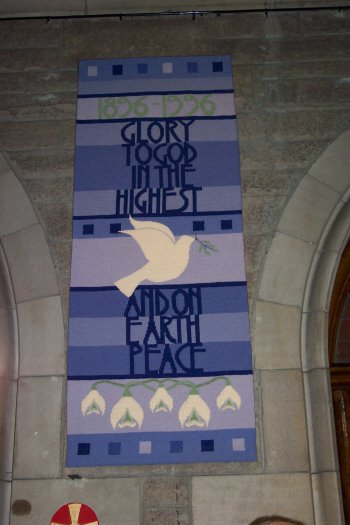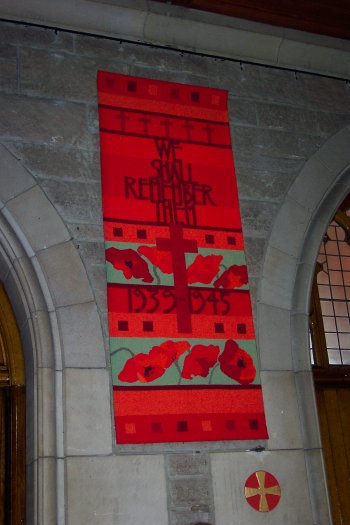A Brief History of St Cuthberts RC Church
It was during the reign of Pope Leo XIII and the Episcopate of Archbishop William Smith that St. Cuthbert’s Parish was established in 1889. Prior to its establishment there were only five parishes within the City of Edinburgh – St. Mary’s Cathedral, St. Patrick’s, The Sacred Heart, St. John the Evangelist in Portobello and St. Mary’s, Star of the Sea.
The first Parish Priest was Monsignor John Forsyth and the scale of his workload can be seen by the fact that the Parish was to cover the whole area from the Pentlands to the Firth of Forth, as far west as Gogarburn taking in Currie, Balerno, Ratho and Corstorphine and Davidsons Mains. In these early days, Mass was celebrated at more than one location until the opening of St. Cuthbert’s School Chapel in Gorgie on 27th July 1890. The Parish Presbytery was occupied from November of 1890.
The commissioning and building of the Church took place within the first few years of the 1890s with funding being supplied to a substantial extent by private donations – a remarkable achievement given that a vast number of the Catholic population lived in dreadful property. The Church, the work of the Architect J.B. Bennett, was ultimately completed and formally opened on 31st May 1896 by Archbishop McDonald. Also in attendance were the Bishops of Aberdeen, Dunkeld and Hexham and Newcastle.
It was not until 1921, thirty-two years after the formation of the Parish, that the first assistant priest was appointed – Fr. Kieran Joyce.
Monsignor Forsyth was to stay in St. Cuthbert’s until his death in 1942 by which time he had served under four Archbishops. His successor was the legendary Monsignor Peter Connolly or Doctor Connolly. In his time, the number of assistant priests reached the high point of six. It is interesting to note how the parish has gone full cycle and is now back to one Parish Priest.
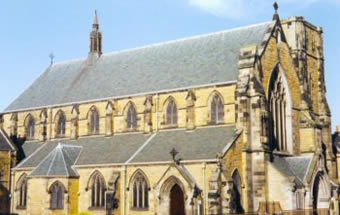 It was also during Monsignor Connolly’s time that the Church was consecrated on 30th May 1956. In those days, it was not possible to have a Church consecrated until all the debt attached to its building had been cleared. The ceremony was carried out with great pomp and ceremony by the then Archbishop Gray (later to become Cardinal Gray). On the day of the ceremony, which lasted over three hours, the Master of Ceremonies, was Father Laurence Davison (later Canon Davison) who was to succeed Monsignor Connolly as Parish Priest of St. Cuthbert’s in 1969. The evidence of the consecration can be seen in the small consecration crosses on the Church pillars and walls.
It was also during Monsignor Connolly’s time that the Church was consecrated on 30th May 1956. In those days, it was not possible to have a Church consecrated until all the debt attached to its building had been cleared. The ceremony was carried out with great pomp and ceremony by the then Archbishop Gray (later to become Cardinal Gray). On the day of the ceremony, which lasted over three hours, the Master of Ceremonies, was Father Laurence Davison (later Canon Davison) who was to succeed Monsignor Connolly as Parish Priest of St. Cuthbert’s in 1969. The evidence of the consecration can be seen in the small consecration crosses on the Church pillars and walls.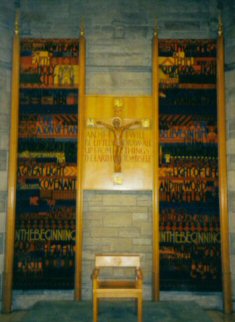
Monsignor Connolly supported by many assistant priests continued to administer the pastoral and liturgical needs of the Church for another thirteen years until in 1969 he moved to Haddington.
His successor was Canon Davison. He found himself caught up in the implementation of the sweeping changes that the Church was undergoing as a result of the second Vatican Council. Having served as Diocesan Master of Ceremonies and being a keen liturgist, he took up the role with enthusiasm. He instigated many liturgical changes and also the necessary alterations to the sanctuary. These were effected under the guidance of Mr. Peter Whiston. In re-planning the sanctuary, all the existing furniture and materials were re-used and incorporated into the new design.
The one exception to this was the addition of the two wall tapestries, linked by the crucifix at the back of the sanctuary area. They illustrate in a colourful and dramatic way the Old and the New Covenant on which our common faith is based. These tapestries were prepared by Mr. Archie Brennan and created in the Dovecot Studios of the Edinburgh Tapestry Company. They were exhibited in the Edinburgh Festival in 1971 and then installed in the Church, being blessed by Cardinal Gray on 3rd July 1972.
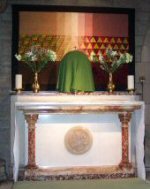 In subsequent years, further smaller hangings were created in the same studio and these can be seen behind the Tabernacle and Baptismal Font. These were hung in October 1979. The final two were created to mark the centenary of the opening of the Church and hang on either side of the main door at the rear of the Church.
In subsequent years, further smaller hangings were created in the same studio and these can be seen behind the Tabernacle and Baptismal Font. These were hung in October 1979. The final two were created to mark the centenary of the opening of the Church and hang on either side of the main door at the rear of the Church.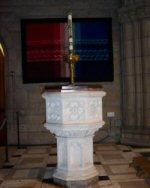
Canon Davison retired from the post of Parish Priest in December of 1989. In his time, many innovations had occurred to keep the Parish in line with Church teaching thinking. The growing emergence of the lay people within the parish was developed. This saw the Parish Council being formed to help and advise in matters pastoral. The introduction of readers, ministers of the Eucharist. Under his leadership, the parishioners began to see the significance of the church, not just as a building, but also as a people, the People of God. They became more aware of the place and role of the laity in the mission of the Church.
Following on Canon Davison’s retirement, Archbishop O’Brien (now Cardinal O’Brien) appointed Father Tony Duffy (now Monsignor) as Parish Priest. He had served with Canon Davison and so knew many of the families entrusted to his care. Along with his duties in the parish he was, like Monsignor Forsyth, Treasurer of the Archdiocese. The Church building is gradually being upgraded to keep it in good order – new seating, new roof, re-wiring and re-lighting have all taken place.
More importantly, the people of the parish continue to grow in their faith and love of God. More and more they see their role as the People of God being critical to the ongoing life of the Parish and the wider Church in the years that lie ahead.
